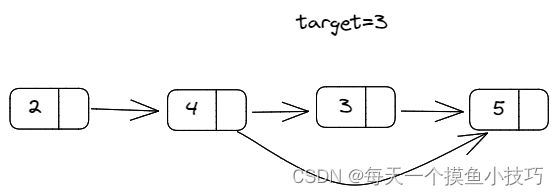代码随想录刷题笔记Day3--链表之移除链表元素 设计链表 反转链表
代码随想录刷题笔记Day3–链表之移除链表元素 设计链表 反转链表
LeetCode 203. 移除链表元素
题目描述:
给你一个链表的头节点 head 和一个整数 val ,请你删除链表中所有满足 Node.val == val 的节点,并返回 新的头节点 。
示例 1:
输入:head = [1,2,6,3,4,5,6], val = 6
输出:[1,2,3,4,5]
示例 2:
输入:head = [], val = 1
输出:[]
解题思路
- 如果是在中间发现了目标数值,那么就把指针指向目标值指针的下一个指针

- 但是存在一种情况,就i是在头节点就发现了目标数值,则处理方法前者不同,head=head->next;

- 在上面那种情况需要使用while循环,切记!

解法:
第一种写法(本人写法)
var removeElements = function(head, val) {
while(head!=null&&head.val===val)
head=head.next;
let t=head;
while(t!=null&&t.next!=null)
{
if(t.next.val===val)
{
t.next=t.next.next;
}
else t=t.next;
}
return head;
};
反思:
- 头节点的情况没考虑到
- 头节点仍然需要循环,因为可能存在上图所示的情况(考虑问题不够全面)
- t需要从头开始
第二种写法(虚拟头节点)
var removeElements = function(head, val) {
let dummyhead=new ListNode();
dummyhead.next=head;
let cur=dummyhead;
while(cur.next!=null)
{
if(cur.next.val===val)
cur.next=cur.next.next;
else
cur=cur.next;
}
return dummyhead.next;
};
反思:
- cur需要从头开始
- return的是虚拟头节点的下一个节点
LeetCode 707. 设计链表
题目描述:
设计链表的实现。您可以选择使用单链表或双链表。单链表中的节点应该具有两个属性:val 和 next。val 是当前节点的值,next 是指向下一个节点的指针/引用。如果要使用双向链表,则还需要一个属性 prev 以指示链表中的上一个节点。假设链表中的所有节点都是 0-index 的。
在链表类中实现这些功能:
- get(index):获取链表中第
index个节点的值。如果索引无效,则返回-1。 - addAtHead(val):在链表的第一个元素之前添加一个值为
val的节点。插入后,新节点将成为链表的第一个节点。 - addAtTail(val):将值为
val的节点追加到链表的最后一个元素。 - addAtIndex(index,val):在链表中的第
index个节点之前添加值为val的节点。如果index等于链表的长度,则该节点将附加到链表的末尾。如果index大于链表长度,则不会插入节点。如果index小于0,则在头部插入节点。 - deleteAtIndex(index):如果索引
index有效,则删除链表中的第index个节点。
示例 :
MyLinkedList linkedList = new MyLinkedList();
linkedList.addAtHead(1);
linkedList.addAtTail(3);
linkedList.addAtIndex(1,2); //链表变为1-> 2-> 3
linkedList.get(1); //返回2
linkedList.deleteAtIndex(1); //现在链表是1-> 3
linkedList.get(1); //返回3
解法
class LinkNode {
constructor(val, next) {
this.val = val;
this.next = next;
}
}
var MyLinkedList = function () {
this.tail = null;
this.head = null;
this.length = 0;
};
/**
* @param {number} index
* @return {number}
*/
MyLinkedList.prototype.get = function (index) {
//如果索引大于链表长度
if (index > this.length - 1) {
return -1;
}
let ptr = this.head;
while (index--) {
ptr = ptr.next;
}
return ptr.val;
};
/**
* @param {number} val
* @return {void}
*/
MyLinkedList.prototype.addAtHead = function (val) {
//建立新增节点
let node = new LinkNode(val, this.head);
this.head = node;
//当链表中无节点时
if (this.length === 0) {
this.tail = node;
}
this.length++;
};
/**
* @param {number} val
* @return {void}
*/
MyLinkedList.prototype.addAtTail = function (val) {
//建立新增节点
let node = new LinkNode(val, null);
//当链表中无节点时
if (this.length === 0) {
this.head = node;
}
//有节点时
else {
this.tail.next = node;
}
this.tail = node;
this.length++;
};
/**
* @param {number} index
* @param {number} val
* @return {void}
*/
MyLinkedList.prototype.addAtIndex = function (index, val) {
//如果索引大于链表长度
if (index > this.length) {
return;
}
//当在头部添加时
if (index === 0) {
//直接调用
this.addAtHead(val);
return;
}
//在尾部添加时
if (index === this.length) {
this.addAtTail(val);
return;
}
//其他情况
//ptr指向插入位置的前一位
index = index - 1;
let ptr = this.head;
while (index--) {
ptr = ptr.next;
}
// 新建节点,让它指向插入位置的值
let node = new LinkNode(val, ptr.next);
ptr.next = node;
this.length++;
};
/**
* @param {number} index
* @return {void}
*/
MyLinkedList.prototype.deleteAtIndex = function (index) {
//如果索引大于链表长度
if (index > this.length - 1 || index < 0) {
return;
}
// 如果index为0,head向后移动一位
if (index === 0) {
this.head = this.head.next;
//如果删除的也是尾节点
if (index === this.length - 1) {
this.tail = this.head;
}
this.length--;
return;
}
let id = index;
//ptr指向插入位置的前一位
index = index - 1;
let ptr = this.head;
while (index--) {
ptr = ptr.next;
}
ptr.next = ptr.next.next;
//删除最后一位
if (id === this.length - 1) {
this.tail = ptr;
}
this.length--;
};
/**
* Your MyLinkedList object will be instantiated and called as such:
* var obj = new MyLinkedList()
* var param_1 = obj.get(index)
* obj.addAtHead(val)
* obj.addAtTail(val)
* obj.addAtIndex(index,val)
* obj.deleteAtIndex(index)
*/
LeetCode 206. 反转链表
题目描述:
给你单链表的头节点 head ,请你反转链表,并返回反转后的链表。
示例 :
输入:head = [1,2,3,4,5]
输出:[5,4,3,2,1]
解法
第一种写法(双指针写法)
/**
* Definition for singly-linked list.
* function ListNode(val, next) {
* this.val = (val===undefined ? 0 : val)
* this.next = (next===undefined ? null : next)
* }
*/
/**
* @param {ListNode} head
* @return {ListNode}
*/
var reverseList = function(head) {
const pre = new ListNode();
let cur=head;
while(cur!=null)
{
let temp=cur.next;
pre=cur.next
pre=cur;
cur=temp;
}
return pre;
};
反思:
一定需要